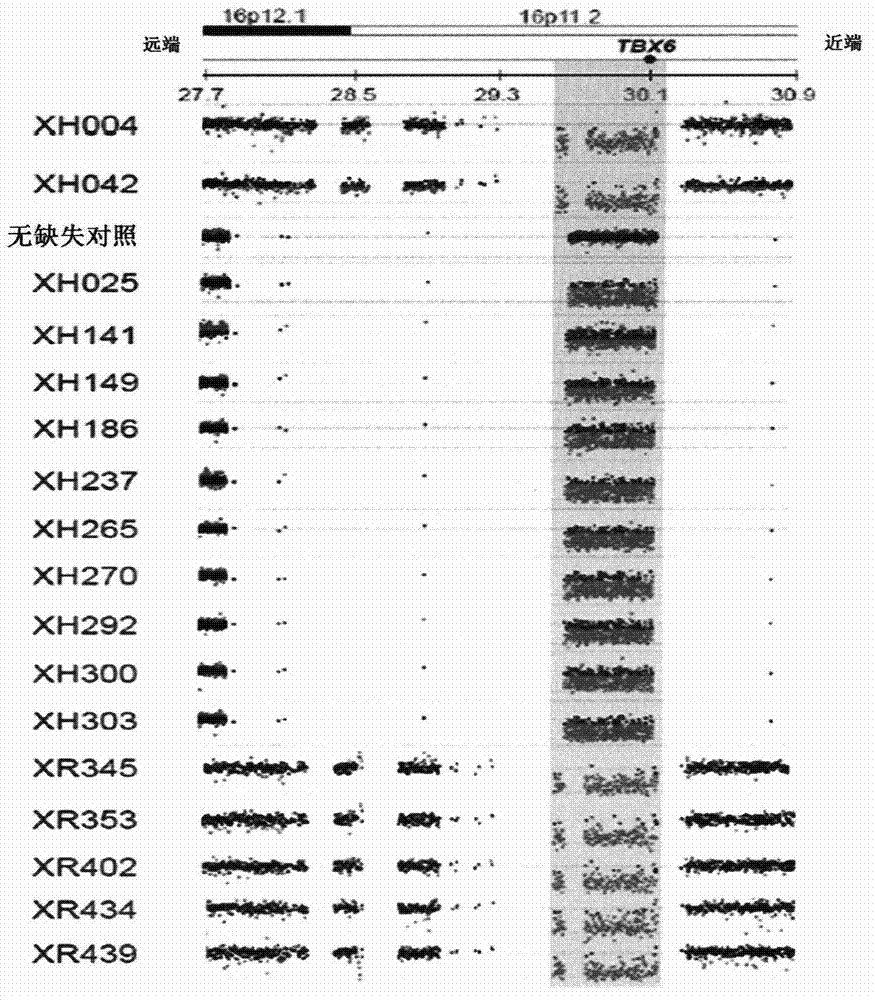Product for diagnosing congenital scoliosis and application of product
A scoliosis, congenital technology, applied in the field of medical diagnosis, can solve problems such as the complexity of the genetic mechanism of low-penetrance human CS
- Summary
- Abstract
- Description
- Claims
- Application Information
AI Technical Summary
Problems solved by technology
Method used
Image
Examples
Embodiment 1
[0053] Example 1 Detection of chromosome 16p11.2 microdeletion
[0054] 1. Blood sampling and genomic DNA extraction:
[0055] All subjects used vacuum EDTA anticoagulation tube to collect 5ml of fasting peripheral venous blood in the morning, centrifuged at 3000rpm / min for 10min, and separated plasma, white blood cell layer and red blood cell. If possible, use lymphocyte separation solution to further extract granulocytes. If unconditional, the white blood cell layer can be directly divided into 2ml cryotubes and stored at -80℃ for later use.
[0056] Use phenol-chloroform method to extract genomic DNA, use ultraviolet spectrophotometry (260 / 280 ratio) to determine DNA purity, OD 260 Determine the DNA concentration, and store it at -20°C for use after unified standardization. Specific steps are as follows:
[0057] (1) Transfer the white blood cell suspension into a 5ml centrifuge tube, add the hemolysis reagent, shake and mix well, centrifuge at 4000rpm / min for 10min, discard the ...
Embodiment 2
[0074] Example 2 Detection of mutations in TBX6 gene
[0075] The common mechanism of nucleotide deletion-related diseases is haplotype insufficiency. For example, the existence of only one key gene copy is not sufficient for the physiological needs of individuals. Considering that the lack of a single dose of TBX6 is a factor in the occurrence of CS, it can be considered that other factors that can lead to the lack of a single dose of the TBX6 gene may also cause the occurrence of CS. Gene mutation is a common factor that causes disease. Next, DNA sequencing of TBX6 gene will be performed to investigate whether the mutation exists.
[0076] 1. Gene amplification
[0077] The entire TBX6 gene coding region and nearly 1kb upstream regulatory region of 149 unrelated CS patients without 16p11.2 microdeletion and 166 randomly selected normal people were amplified. The primer sequence was: forward primer 5'- TAGGGAGAGGGCTCTGTTCTCATGG-3'; reverse primer 5'-GCGTCCCAGGGAGGCAACCG-3'. The P...
Embodiment 3
[0087] Example 3 Repeated detection of chromosome 16p11.2 microdeletion and mutation of TBX6 gene
[0088] 1. Duplicate detection of chromosome 16p11.2 microdeletion
[0089] Participants: 76 unrelated Chinese Han people with congenital scoliosis.
[0090] Method: Same as Example 1.
[0091] Results: Of the 76 unrelated Chinese Han people with congenital scoliosis, 5 of the genomes had chromosome 16p11.2 microdeletion ( figure 1 The last 5 kinds of deletion).
[0092] 2. Repeat detection of TBX6 gene mutation
[0093] Participants: 71 unrelated Han Chinese with congenital scoliosis and no microdeletion of chromosome 16p11.2.
[0094] Method: Same as in Example 2.
[0095] Results: One of 71 Chinese Han people with congenital scoliosis and no relatives and no microdeletion of chromosome 16p11.2 had a double nucleotide deletion, that is, a deletion of AG at C1179 ( figure 2 Shown in E).
PUM
 Login to View More
Login to View More Abstract
Description
Claims
Application Information
 Login to View More
Login to View More - R&D
- Intellectual Property
- Life Sciences
- Materials
- Tech Scout
- Unparalleled Data Quality
- Higher Quality Content
- 60% Fewer Hallucinations
Browse by: Latest US Patents, China's latest patents, Technical Efficacy Thesaurus, Application Domain, Technology Topic, Popular Technical Reports.
© 2025 PatSnap. All rights reserved.Legal|Privacy policy|Modern Slavery Act Transparency Statement|Sitemap|About US| Contact US: help@patsnap.com



